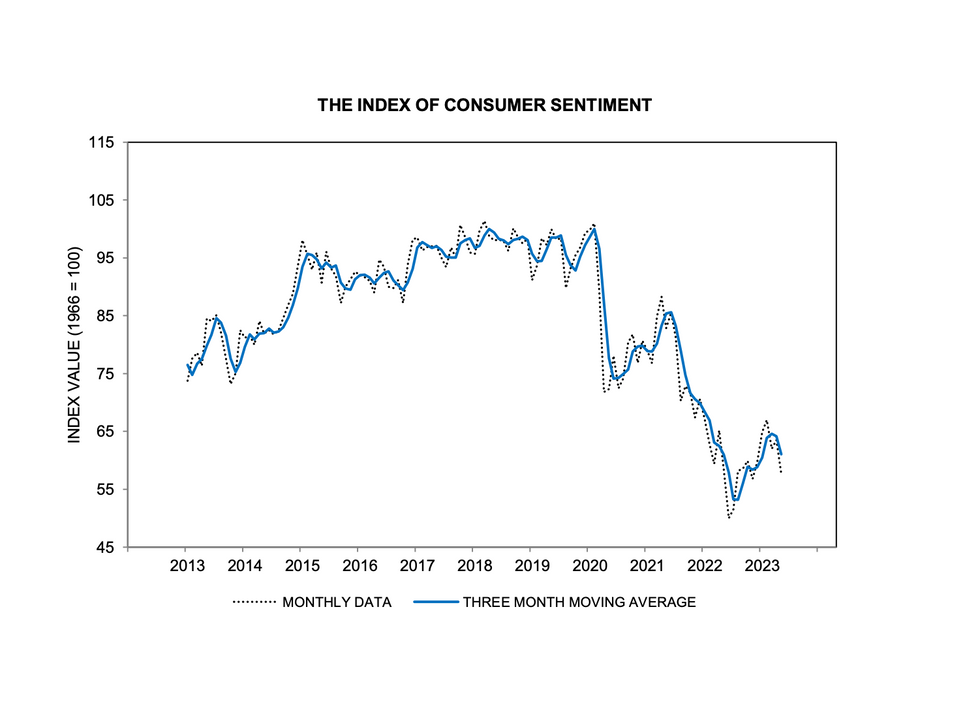Economy
12 May 2023
Consumer worries drop sentiment to 6-month low to start May
The debt ceiling crisis is weighing on consumers, erasing gains made in recent months.

The debt ceiling crisis is weighing on consumers, erasing gains made in recent months.

Consumer sentiment dipped to a six-month low to begin May, as worries about the economy renewed and the debt ceiling debate delivered another dose of uncertainty into the American public.
According to the University of Michigan, sentiment fell 9% in the first May reading. This metric had been climbing steadily since hitting a historic low last June. But the preliminary May reading erased half of the gains made in recent months.
There were precipitous falls across the survey. Year-ahead expectations fell 23%, while long-run expectations were down 16%.
Consumers are seeing more negative news about the economy, and the federal debt ceiling standoff between Republicans in Congress and US President Joe Biden is particular cause for alarm.
“Throughout the current inflationary episode, consumers have shown resilience under strong labor markets, but their anticipation of a recession will lead them to pull back when signs of weakness emerge,” University of Michigan Survey of Consumers Joanne Hsu wrote. “If policymakers fail to resolve the debt ceiling crisis, these dismal views over the economy will exacerbate the dire economic consequences of default.”
There are also signs that consumers believe inflation will stay higher. Long-run inflation expectations hit their highest reading since 2011, rising to 3.2% from 3% in April. Meanwhile, year-ahead expectations dipped slightly to 4.5% after a 4.6% reading in April that UMich described as “spiking.”
This result comes after the latest Consumer Price Index data showed that inflation cooled only slightly in April to 5%. GlobalData Managing Director Neil Saunders wrote of a “frugal mindset” taking shape among consumers."
Nevertheless, there was one sign this week that there could be more relief on the way on inflation. The Producer Price Index, which measures wholesale inflation, rose 2.3% on an annual basis. That's a further cooling from 2.7% in March. The PPI is seen as a forward-looking indicator of inflation.

Labor disputes on the West Coast could cause further disruption heading into peak season.
When the first half of 2023 is complete, imports are expected to dip 22% below last year.
That’s according to new data from the Global Port Tracker, which is compiled monthly by the National Retail Federation and Hackett Associates.
The decline has been building over the entire year, as imports dipped in the winter. With the spring, volume started to rebound. In April, the major ports handled 1.78 million Twenty-Foot Equivalent Units. That was an increase of 9.6% from March. Still it was a decline of 21.3% year over year – reflecting the record cargo hauled in over the spike in consumer demand of 2021 and the inventory glut 2022.
In 2023, consumer spending is remaining resilient with in a strong job market, despite the collision of inflation and interest rates. The economy remains different from pre-pandemic days, but shipping volumes are beginning to once again resemble the time before COVID-19.
“Economists and shipping lines increasingly wonder why the decline in container import demand is so much at odds with continuous growth in consumer demand,” said Hackett Associates Founder Ben Hackett, in a statement. “Import container shipments have returned the pre-pandemic levels seen in 2019 and appear likely to stay there for a while.”
Retailers and logistics professionals alike are looking to the second half of the year for a potential upswing. Peak shipping season occurs in the summer, which is in preparation for peak shopping season over the holidays.
Yet disruption could occur on the West Coast if labor issues can’t be settled. This week, ports from Los Angeles to Seattle reported closures and slowdowns as ongoing union disputes boil over, CNBC reported. NRF called on the Biden administration to intervene.
“Cargo volume is lower than last year but retailers are entering the busiest shipping season of the year bringing in holiday merchandise. The last thing retailers and other shippers need is ongoing disruption at the ports,” aid NRF Vice President for Supply Chain and Customs Policy Jonathan Gold said. “If labor and management can’t reach agreement and operate smoothly and efficiently, retailers will have no choice but to continue to take their cargo to East Coast and Gulf Coast gateways. We continue to urge the administration to step in and help the parties reach an agreement and end the disruptions so operations can return to normal. We’ve had enough unavoidable supply chain issues the past two years. This is not the time for one that can be avoided.”